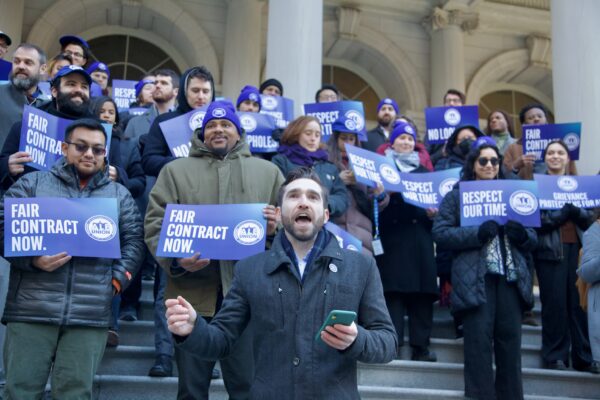February 1, 2013
Marc Bussanich
Mayor Michael Bloomberg has said that the city is spending too much money—$1.1 billion—on transporting children to school and needs to find savings to reinvest the money for classrooms. While the Mayor blames wage inflation, the Amalgamated Transportation Union, representing striking school bus drivers, revealed some of the reasons for the increased costs at a press conference. Read more and watch video
Just before the strike started, the Mayor noted that the city is already realizing savings of $95 million when it issued new bids to companies for transporting pre-kindergarten children last year, but the union says that the bus operators and City Hall refuse to release documents to prove that claim.
Larry Hanley, president of the ATU, cited a recent report by the NYC Center for Economic Activity that reveals that the poverty level in the city is $30,055 annually for a family of four.
“To put that into perspective in terms of what ATU members earn in the school bus industry in the city, the average annual salary for an ATU Local 1181 member is $35,000. Drivers average $45,000 annually and matrons earn top pay of $28,000 annually. Bus drivers are being scapegoated for the dramatic rise in transportation costs, but the wage growth has barely kept up with inflation since 1979—increasing a mere .06 percent,” said Hanley.
Hanley, along with Michael Cordiello, president of ATU Local 1181 and Vincent Alvarez, President of the city’s Central Labor Council, explained some of the reasons behind rising school transportation costs.
“The special education population has mushroomed in the last three decades. School officials say about 52,000 out of 150,000 students [being transported to private, parochial and charter schools] are special education students, who in 1979 accounted for less than a quarter of students being bussed. As the population has mushroomed, the need for more buses have contributed to higher costs,” Hanley said.
According to Hanley, the high cost of transporting special needs students, roughly three-quarters of the $1.1 billion cost, or more than $770 million, is due to inefficient designs of special needs bus service.
“The city claims it costs the city an average of $12,000 per child to transport them. In contrast, the cost of bussing general education students in the city at about $2,600 per student compares favorably to other cities such as Los Angeles ($3,200 per child) and Boston ($3,500).”
In addition, there were 2,200 routes in 1979. Today, drivers transport students on nearly 8,000 routes.
The city can also save money by replacing low-capacity vans with school buses, which can transport up to 60 students on one trip, according to Hanley.
Despite Mayor Bloomberg rebuking the union’s offer to end the strike in return for the city postponing bids for new contracts, the union continues to seek a resolution.
The CLC’s Alvarez said in an interview that the biggest imperative is to end the strike, get the drivers back on the job and then initiate a taskforce consisting of the union, the city and parents to explore ways to map out more efficient routes so that bus drivers aren’t driving long distances from Brooklyn to Westchester, which could potentailly reduce costs.



